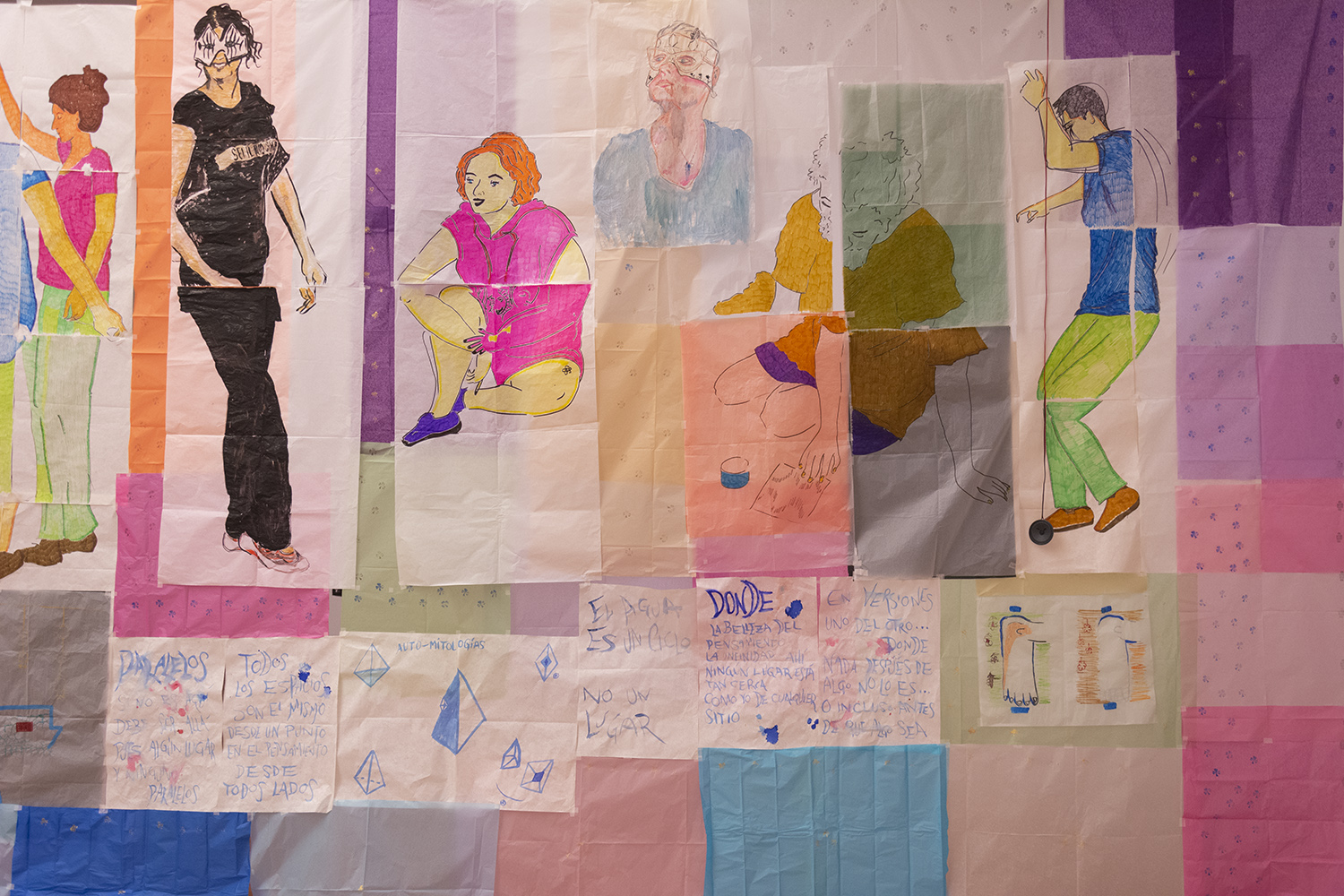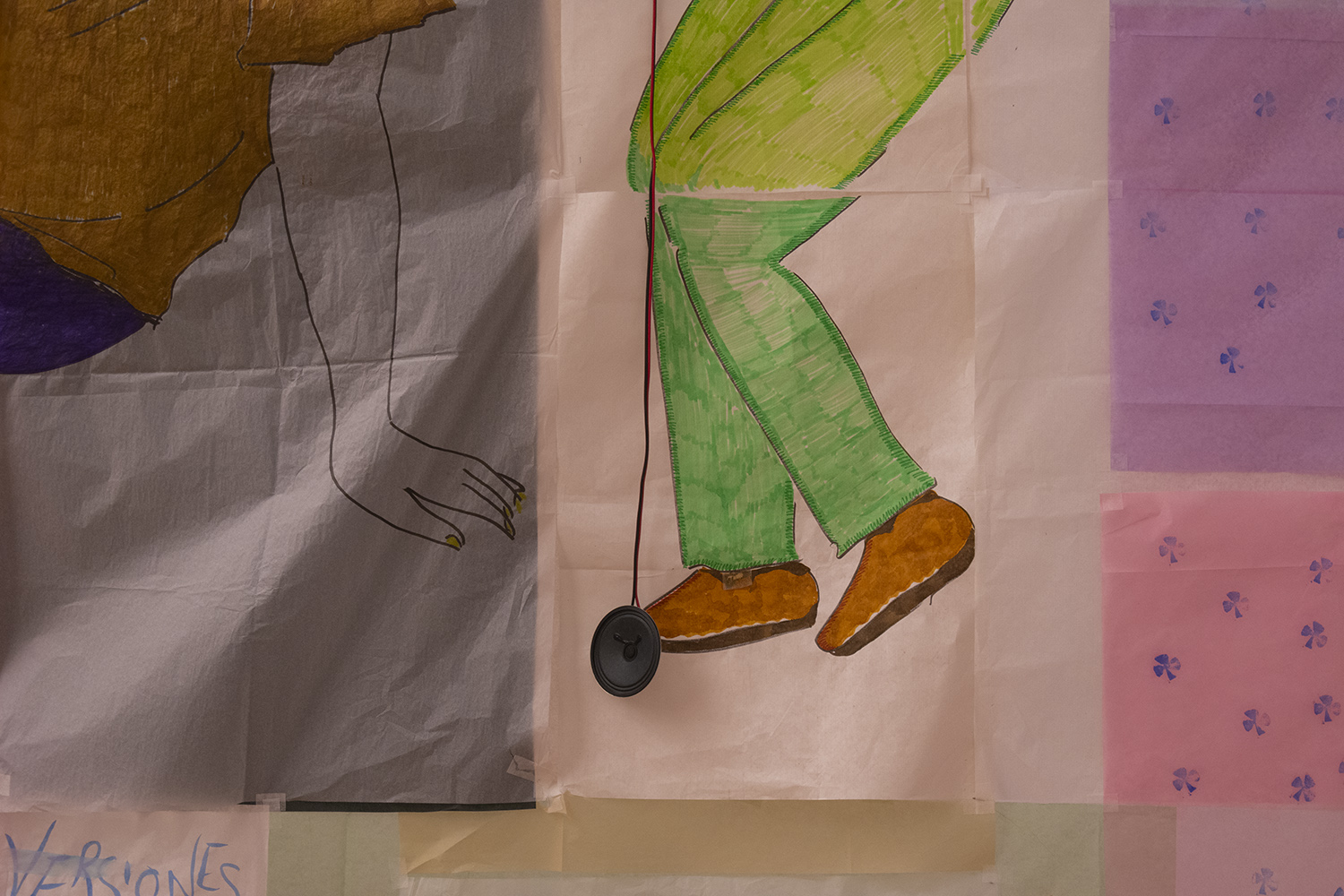Urak dakar - Exhibition
EXHIBITION: URAK DAKAR. ON LEAVING THE WORKSHOP
by
Urak Dakar. On leaving the workshop is a group show that brings together works by Equipo Jeleton, Marion Cruza Le Bihan and Aitor Izagirre, Tripak (with Haiek) and the participants in the drawing workshop led by Raúl Domínguez. In 2022 these artists held four workshops as part of the Urak dakar program. At four specific times during the present show the artists will carry out an activity related to their work.
Urak dakar is the 2022-2023 edition of Space is the Place / The Place is Space. Started in 2018, the program’s title paraphrases that of a 1974 Afrofuturist film by Sun Ra.
OPENING:
24/11/23 – 17:00
PLACE:
Sala Chillida, Bizkaia Aretoa
Avenida Abandoibarra 3, 48009-Bilbao
DATES & OPENING HOURS:
November 24, 27, 28 and 29; December 1, 4 and 5.
11:00-20:00
ACTIVITIES:
27/11/23 – 18:00: Tokimagik with Equipo Jeleton
01/12/23 – 18:00: Urak daroa (or destruction of the Balco) with Marion Cruza Le Bihan and Aitor Izagirre
04/12/23 – 18:00: Drawing workshop with Raúl Domínguez
05/12/23 – 18:00: Urak dakar. On leaving the workshop…and later with Bulegoa z/b
To take part in the activities, please contact bulegoa@bulegoa.org
URAK DAKAR. ON LEAVING THE WORKSHOP
In 2022 we invited Raúl Domínguez, Equipo Jeleton, Marion Cruza Le Bihan and Aitor Izagirre, and Tripak to hold four workshops in the framework of Urak dakar (Water Brings). The invitation was accompanied by a second commission: to take part in a group show the following year. Our proposal was that they should put into practice two ways of showing artistic processes, each of them with its specific times, spaces and dynamics. On one side, the more private and reserved context of the workshop, where the artists share their ways of working and methodologies with a group of people; on the other, the public framework entailed in the show, where the artist is no longer present and the works are presented autonomously.
Although the invitation left the possibility open for the inclusion of works in the show that were not necessarily derived from the workshops, we hoped that some of that prior experience would somehow filter through into the show. In any case, each artist was free to adapt the invitation to his or her own circumstances, always subject to the open character, uncertainly and precariousness that are characteristic of both artistic and collective processes. The only certain factor was the framework: Urak dakar, the 2022-2023 edition of Space is The Place/The Place is Space, whose aim is to generate situations and imagine ways of living and producing space, and proposes thinking in situ, in the space and with the place.
WORKS AND ARTISTS IN THE EXHIBITION:
DRAWING WORKSHOP WITH RAÚL DOMÍNGUEZ
“Before getting down to drawing there is a silence in which we emerge from daily inertia.
“Drawing involves entering into another time of life, in which it is necessary to be present and bodily involved. Living the image rather than passively receiving it.
“To achieve a real encounter with things, it is necessary to create a space of possibility in which, at some moment, everything can be upside down. Placing what is already seen, what is already known into crisis. Reaching pointlessness and returning”. [Text of the call for applications to take part in the drawing workshop]
*
In March 2022, 12 people met for four practical drawing sessions.
Basically, the workshop proposed experiencing the difference between passively receiving an image and the experiential process of making it with our hands. In drawing we discovered a way of looking that involved us bodily, an activity that does not separate thinking from drawing.
The singularity of the resulting drawings derives from the commitment of the participants and they make visible some of the movements and structures that take place around us and inside us.
Participants in the 2022 Drawing Workshop: Txabi Angulo, Pedro Canive, Conchi Carazo, Jesús Cardaño, Teo Delgado, Maribel Ochoa de Alda, Marga Parriel, Feli Ruiz Díez, Edurne Sagarna, Jaime Val Sáez and Javier Vicario.
TOKIMAGIK BY EQUIPO JELETON
Tokimagik unfolds the space-times and relational worlds that are invoked in a workshop. In the words of Sun Ra, the genius who protects the Project, in his poem Parallels (1972):*
If it is not here
It must be there
For somewhere and nowhere
Parallels
In versions of each other…. where
Or even before something came to be
The following participated in the 2022 Tokimagik workshop with drawings and performances: Leire Aranberri, Jesús Arpal Moya, Aimar Arriola, @art.worldbuilding, Amparo Badiola, Beatriz Cavia, Santiago Fernández Mosteyrin, Eva García Fernández, Gema Intxausti, Miren Jaio, Gelen Jeleton, Laida Lertxundi, lucia, Maite Martínez de Arenaza, Izar Ocariz, Kristina Ortiz, Ander Pérez, Irene Pérez, Ainize Sarasola, Susana Talayero, Josune Urrutia Asua, Víctor, Gabriel Aparicio Rey, Paula Martínez Sancho and Paola Vega.
URAK DAROA (OR DESTRUCTION OF THE BALCO) BY MARION CRUZA LE BIHAN AND AITOR IZAGIRRE
X/2013 – Exploration.
V/2014 – The Mercadona of scrap, hand to mouth pillaging.
X/2014 – The abandoned warehouse burns.
V/2016 – Fire in the building housing the old offices. The archive is destroyed.
I/2017 – Old factory in flames once again.
IX/2017 – Bilbao: identity crisis and periphery.
II/2018 – Trapagarán prepares the terrain for the disembarkation of Amazon.
VII/2019 – The historical offices of Galindo in the process of being demolished.
XI/2019 – The X never marks the place. Group walking.
XII/2019 – Fall of the 10 original pavilions.
V/2021 – The former refectories completely burnt out.
VII/2022 – Route from here, Durañona.
Participants in the workshop/collective exploration Route from here in 2022: Charo, Miguel, Oihana, Justo, Rafa, Joseba, Hugo, Jugatx, Israel, Ula, Yeray, Eider, Terri, Álvaro, Ibon, Silvia, Pablo, Miren, Aitor, Begoña, Marce, Aitor and Marion.
POSIDONIA: TRIPAK + HAIEK
Architectures of the end of the world are those that construct the future end of the world. They help in its definition, they accompany it when it dies, or they die for it.
The structure of Tripak Haiek is constantly dying, helping us to think about the crisis, decadence and caring relationships or, at least, to be attentive in that process.
The structure is like a living being, and the bodies, as they are inanimate, are committed to it, tearing themselves apart, and disembowelling it.
*
The young woman says that the fountain is a person, and at the same time a wave, as brilliant as an emerald. She has no arms, no face, she is blind, she walks without moving, so as not to undo the folds of water that surround her.
Today we have gorged ourselves on lobster. I brought two weighing two kilos, and another four smaller ones. I caught them in green water. It was like moving inside a bottle. An unrepeatable impression. It’s water from the Orinoco.
Participants in the Tripak Workshop in 2022: Izarne Oyarzabal, Candela Azpiroz, Ander Pérez Puelles, Hodei Herreros Rodríguez, Víctor Ortuño, Kristina Ortiz, Esterling Suriel, Leire Ugalde Blanco, Paula Brezo Allende, Judith Voet, Narlin Roman, Izar Ocariz and Ainhoa Pardellas.
BIOS
Raúl Domínguez (Barakaldo, 1984) is an artist. His work is centred on drawing. He currently combines his artistic work with scientific illustration, design and teaching. His most recent exhibitions include the following: Media hora de sol and Palabra de conejo at the Galería Carreras Múgica (Bilbao), Es ir a at the Galería Pelaires, Palma de Mallorca, Ambergris at Carbonería Lorences (Madrid), Re-Ilustrazioa (together with Ángela Palacios) curated by Oier Etxeberria at the Fundación Cristina Enea (Donostia-San Sebastián), First thought best curated by Peio Aguirre, Beatriz Herráez and Itziar Okariz at ARTIUM (Vitoria-Gasteiz), Gabinete Abstracto at sala rekalde (Bilbao), and Otzan (group show) at the Galería Elba Benítez (Madrid).
Equipo Jeleton is formed of Jesús Arpal Moya and Gelen Alcántara Sánchez. Using experimental mythologies they elaborate narrative languages that range from poetry to singing, choreographed in drawing. They unceasingly surrender to, and rebel against, the power of images and symbols. Recently they have shown their art at Black Maritxu (Arrieta, Bizkaia), MNCARS (Madrid), Museum of Fine Arts of Bilbao, MACBA (Barcelona), Fundación Miró (Barcelona).
Marion Cruza Le Bihan and Aitor Izagirre are artists as well as teachers. They have collaborated on different projects since the year 2013, in particular on the exhibition Giltzapekoak: Notas sobre la reclusión (Under lock and key: Notes on Reclusion) which they curated together with Pablo Marte (Koldo Mitxelena Kulturunea, Donostia-San Sebastián, 2016). Basing herself on practice, Marion investigates ways of imaging films and the construction of “scenes”. This includes works in video and photography, writing dialogues, performances, drawings and installations. Aitor studied philosophy in Donostia-San Sebastián and has participated in the Basque experimental music scene for many years. He has published diverse texts in fanzines and magazines.
Tripak. Basque scenic art company formed of the visual artists Maite Mugerza, Natalia Suárez and Marina Suárez, and the violinist Andrea Berbois. It was founded in 2013 in the Sala Baratza (Vitoria-Gasteiz), in the context of the Laboratorio de Creación, with the aim of offering creations based on their particular view of the world and aesthetics.
Haiek. The artistic career path of Haiek started in 2005, when the artist Ion Arregi and the architect Martín Ferrán worked together for the first time on the project titled “elminius modestus”. Their individual artistic practices involved other works in the fields of design, architecture, furniture and toys, until they received their first exhibition commission in 2017. In 2020 they created the Haiek cooperative, which provided a new starting point to these works.
Tripak + Haiek. The collaboration between Tripak (Maite Mugerza, Marina Suárez Ortiz de Zárate, Natalia Suárez Ortiz de Zárate and Andrea Berbois) and Haiek (Ion Arregi and Martín Ferrán) arose from the encounter between a company that seeks to analyse its concerns in a scenic format and another that does the same with architecture and constructive forms. This encounter is developed on the basis of observing the process itself, the pleasure and the tension of the encounter between different bodies.
Urak dakar recieves support from the Basque Government, the Regional Government of Bizkaia and BBK Foundation.

















